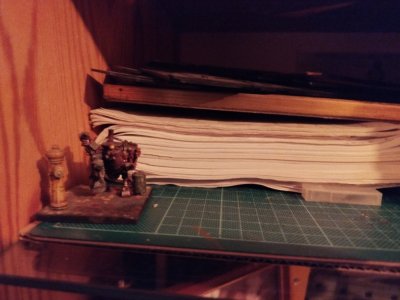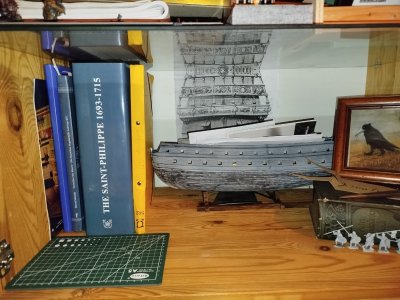Thanks a lot Jimsky!Happy Birthday, Chris!
-

Win a Free Custom Engraved Brass Coin!!!
As a way to introduce our brass coins to the community, we will raffle off a free coin during the month of August. Follow link ABOVE for instructions for entering.
-

PRE-ORDER SHIPS IN SCALE TODAY!
The beloved Ships in Scale Magazine is back and charting a new course for 2026!
Discover new skills, new techniques, and new inspirations in every issue.
NOTE THAT OUR FIRST ISSUE WILL BE JAN/FEB 2026
You are using an out of date browser. It may not display this or other websites correctly.
You should upgrade or use an alternative browser.
You should upgrade or use an alternative browser.
SAINT PHILIPPE 1693 based on the Heller SR 1:92
- Thread starter Iterum
- Start date
- Watchers 8
-
- Tags
- heller saint philippe
Just found your blog, very interesting snd informative. Allthough I only work with wood, your work is stunning.
I found your paint description fantastic, also for somebody building in wood.
Getting the right colors is uplifting the model.
I will be following your blog from now on.
I found your paint description fantastic, also for somebody building in wood.
Getting the right colors is uplifting the model.
I will be following your blog from now on.
Fantastic research, I have learned much from your drawings and comments, hard to believe this is a plastic model.
Thanks a lot Marten and Ziggy!
I am in rebuilding my ship yard in my new cellar and hope to restart buulding in a few days - hopefully.
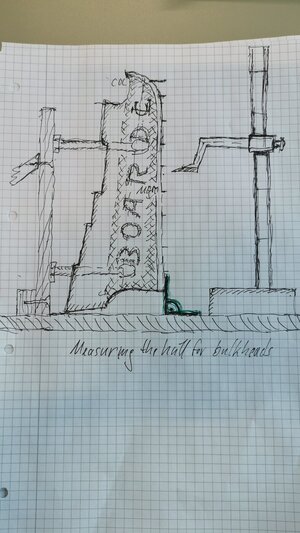
Next step must be the positioning of the hull to measure the frames locations to recreate a proper dreathwood.
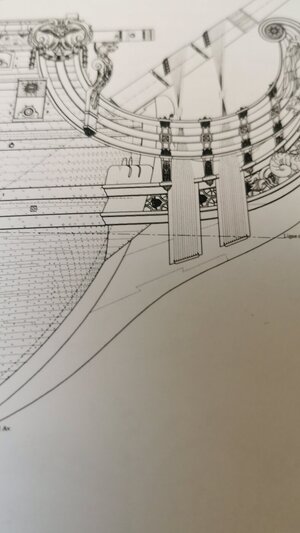
I am still in troublewith the location of the waterline as in the Heller kit it istoo deep here she isn't matching the XX feet points on both sides at stem and stern so the good news is it isn't bent the bad one is she is pivoted.
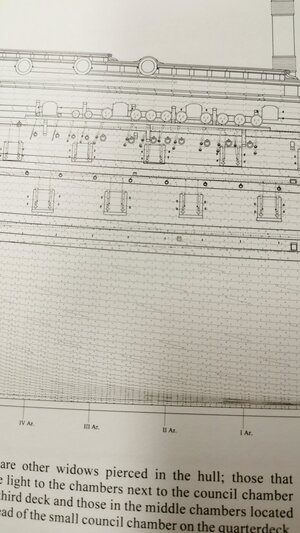
So the drawing has to be revisited and I have to find the right position onto the hull - but the drawing table has been established in my "tidy room" above the yard.
I am in rebuilding my ship yard in my new cellar and hope to restart buulding in a few days - hopefully.

Next step must be the positioning of the hull to measure the frames locations to recreate a proper dreathwood.

I am still in troublewith the location of the waterline as in the Heller kit it istoo deep here she isn't matching the XX feet points on both sides at stem and stern so the good news is it isn't bent the bad one is she is pivoted.

So the drawing has to be revisited and I have to find the right position onto the hull - but the drawing table has been established in my "tidy room" above the yard.
Last edited:
Hello team,
still I am dealing with my removal and the less stable floor and my book shelfs for ten thousands of books in an old house. So there is not too much progress on SAINT PHILIPPE.
And so recently I found my stash of 2mm plastic sheets in DIN A2 (420x594mm) for the planking. The removal boxes with all the documents and the huge pile of rolls with the 1/64 plans are stored in one place now. Due to this I made some first doodlings in meetings and boring phone calls. Doing so I figured out some problems about the Flat and the keeping of the distinguished shape of the hull I want to show as the Heller hull has this overdone edge.*
I. GUNPORT LIDS CONTINUOUS GRAIN?
My most important problem is that of the planking's grain front and sidewards. So - as I have to imitate the grain on any plank individually by sandpaper and scribing tools I do need to ask if the hull was really planked and the gunports were sawn out and stored for this particular lid's outside to stay with the original run of the grain? Planks were than to handle in a much more complex way on the mode - I would have to plank over the gun port's opening and then cut out the lids surface - note the gunport (for example "LD- VI stb" as L_ower D_eck's 6th gunport on starboard side from the stern).
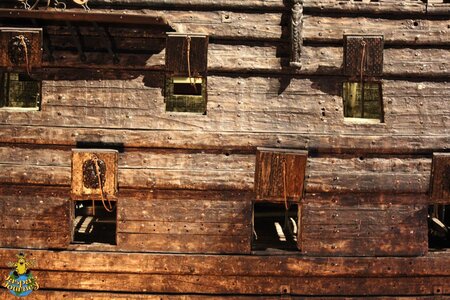
On the VASA I didn't find any picture showing an closed gunport lid proofing the homogenous grain "dogma". So my problem ist still there...Anybody has found any sources for the baroque kind of "producing" gun port lids in France? If it is only a theory live would be easier as I could produce the lids seperatly and are more free due to the end grain, too. So this is an important question for a very time consuming job cutting out the lids by a resin saw to get the smoothest cut with most straight selvages (if this is possible at all in my scale).
II.
Were the gunport lids hanging nearly vertical able to be opened by the ropes intended to do so? As it is important to keep the rope away from the hull so a sufficient force could open the heavy lid?
a) So were the openings for the ropes over the angles prolonged ( looking a bit like scuppers?) to make the process mechanically possible
or
b) were the rings (taking the ropes endings) constructed standing out farer from the lid's surface?
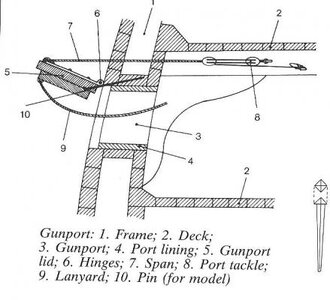
Here the zu Mondfeld's drawing with the nail to fix the lid in position on the model's hull
III.
At the moment I am still struggling with my measurement area to get it horizontally leveled. But we are on a good way with minimum deviation. There is bright daylight and my tool boxes do appear one by one getting piled by my side. The room does start to turn into a shipyardlibarymeasurementroom** so I invest a lot of time in here to adjust my wishes into the given room and furniture.
Thanks for your intrest and support.
* @Hubac’s Historian Marc! You -I have to admit - made the perfect work around...
** such a perfect word for German Scrabble players...
still I am dealing with my removal and the less stable floor and my book shelfs for ten thousands of books in an old house. So there is not too much progress on SAINT PHILIPPE.
And so recently I found my stash of 2mm plastic sheets in DIN A2 (420x594mm) for the planking. The removal boxes with all the documents and the huge pile of rolls with the 1/64 plans are stored in one place now. Due to this I made some first doodlings in meetings and boring phone calls. Doing so I figured out some problems about the Flat and the keeping of the distinguished shape of the hull I want to show as the Heller hull has this overdone edge.*
I. GUNPORT LIDS CONTINUOUS GRAIN?
My most important problem is that of the planking's grain front and sidewards. So - as I have to imitate the grain on any plank individually by sandpaper and scribing tools I do need to ask if the hull was really planked and the gunports were sawn out and stored for this particular lid's outside to stay with the original run of the grain? Planks were than to handle in a much more complex way on the mode - I would have to plank over the gun port's opening and then cut out the lids surface - note the gunport (for example "LD- VI stb" as L_ower D_eck's 6th gunport on starboard side from the stern).

On the VASA I didn't find any picture showing an closed gunport lid proofing the homogenous grain "dogma". So my problem ist still there...Anybody has found any sources for the baroque kind of "producing" gun port lids in France? If it is only a theory live would be easier as I could produce the lids seperatly and are more free due to the end grain, too. So this is an important question for a very time consuming job cutting out the lids by a resin saw to get the smoothest cut with most straight selvages (if this is possible at all in my scale).
II.
Were the gunport lids hanging nearly vertical able to be opened by the ropes intended to do so? As it is important to keep the rope away from the hull so a sufficient force could open the heavy lid?
a) So were the openings for the ropes over the angles prolonged ( looking a bit like scuppers?) to make the process mechanically possible
or
b) were the rings (taking the ropes endings) constructed standing out farer from the lid's surface?

Here the zu Mondfeld's drawing with the nail to fix the lid in position on the model's hull
III.
At the moment I am still struggling with my measurement area to get it horizontally leveled. But we are on a good way with minimum deviation. There is bright daylight and my tool boxes do appear one by one getting piled by my side. The room does start to turn into a shipyardlibarymeasurementroom** so I invest a lot of time in here to adjust my wishes into the given room and furniture.
Thanks for your intrest and support.
* @Hubac’s Historian Marc! You -I have to admit - made the perfect work around...
** such a perfect word for German Scrabble players...
Hi "Iterum", Chris
The port-lids were manufactured as retrofit parts after the actual construction of the ship. Sometimes they were shot up or rotten so they were rebuild. The outer boards of the lids followed the course of the planking.
The lids are opened with the help of the gunnery crew by pushing them open from the inside. Due to their own weight and the unfavorable lever for opening, they cannot otherwise be pulled up.
Best regards
Thomas
The port-lids were manufactured as retrofit parts after the actual construction of the ship. Sometimes they were shot up or rotten so they were rebuild. The outer boards of the lids followed the course of the planking.
The lids are opened with the help of the gunnery crew by pushing them open from the inside. Due to their own weight and the unfavorable lever for opening, they cannot otherwise be pulled up.
Best regards
Thomas
Last edited:
Thanks Tom,
that is very very helpful! Thanks a lot!!!
And is going to save a lot of time in the construction...
So I just have to have an eye on the alinement of the planks to get smooth lines - uninterrupted by the gunports.
that is very very helpful! Thanks a lot!!!
And is going to save a lot of time in the construction...
So I just have to have an eye on the alinement of the planks to get smooth lines - uninterrupted by the gunports.




